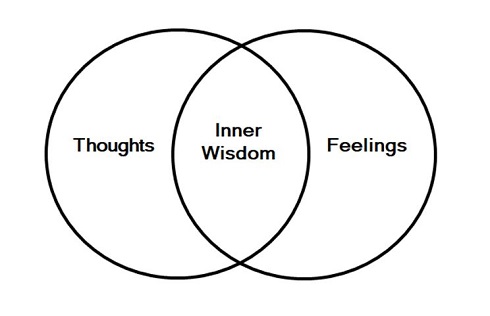I have become aware of an inner state of intensity.
I have become aware I am giving my attention to ______________.
I have become aware that I am feeling ______________, ______________, and ______________.
I am becoming aware that I am thinking these thoughts: ______________, ______________, and ______________.
I monitor the inner volume on the intensity of my feelings and adjust up or down to shift myself to a stable range.
To help myself adjust my inner volume, I first assess the safety of the situation. If it is safe, I shift my attention to my senses. I become aware of what I am seeing, hearing, tasting, touching, smelling, and motions around me.
I ask myself, “Am I feeling natural, primary feelings (mad, sad, glad, afraid), or secondary feelings (shame, blame, panic, rage) resulting from judgments about myself, others, or how things should be?”
If I am feeling primary feelings – normal, human feelings that happen without thought – I make supportive, reassuring statements to myself. I practice self-kindness and self-care.
If I am feeling secondary feelings that result from thoughts, without judgment, I sort my thoughts by labeling them “helpful” and “unhelpful.” I shift my attention to the “helpful” thoughts.
In the category of “helpful thoughts,” I may have placed problematic beliefs. I sort my thoughts into facts and beliefs. I challenge my beliefs with facts. I try replacing absolute, all-or-nothing thoughts – such as “always, “never,” “all,” every,” “everyone” – with “some,” “many,” “most.”
Although I might wish otherwise, these are the facts: ______________, ______________, and ______________.
Kind, self-supportive statements I can say to myself about these facts are: ______________, ______________, and ______________.
As a result of managing my attention,, adjusting the inner volume on my feelings, and sorting my thoughts, I now have access to my inner wisdom. I can consult my inner wisdom for guidance.
My inner wisdom helps me discern between safe and unsafe situations, know and use my strengths, power me with my values, orient me towards my priorities, handle that opposites can both be true, and do a cost-benefit analysis, with ranking ordering to decide what I might – or might not – say or do next.
If connection is desired or needed, I spend time with kind, supportive people. I use awareness to foster safety, become aware of attunement, listen reflectively, notice and acknowledge others’ thoughts and realities, empathize with (safe) others’ feelings, and intentionally resolve conflicts. Awareness helps me be present for myself and others.
Awareness helps me practice self-kindness and other-kindness.
. . . . .
This awareness-fostering, self-narrative is an evolving attempt to distill the research on personal practices that can help most people, most of the time, better than other methods, and better than nothing, with the symptoms of substance use disorders, anxiety, depression, thought disorders, personality disorders, neurodevelopmental disorders, physical pain, and other challenges. Among other modalities, the skills are informed by cognitive behavior therapy, dialectical behavior therapy – mindfulness, emotion regulation, distress tolerance, and interpersonal effectiveness – and cognitive processing therapy. The skills are not a substitute for professional help. Given that many challenges are experienced 24-7, and wait lists for professional care exist in many locales, the skills are offered as an adjunct to professional care, and, perhaps, to help people feel a little better.
The views expressed are mine alone and do not necessarily reflect the positions of my employers, co-workers, clients, family members or friends. This content is for informational purposes only and is not a substitute for medical or professional advice. Consult a qualified health care professional for personalized medical and professional advice.


